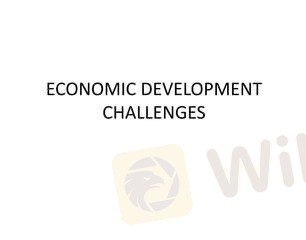
2025-02-14 03:45
IndustryEconomic development:strategies, challenges
#Firstdealoftheyearchewbacca
Economic development refers to the sustained increase in the standard of living and economic health of a country, region, or community. It involves broad improvements in key areas such as income levels, education, healthcare, and infrastructure. However, achieving economic development involves carefully crafted strategies, navigating multiple challenges, and establishing robust institutions. Let’s dive into each of these elements in greater detail.
1. Economic Development Strategies
Economic development strategies encompass various policy approaches designed to foster economic growth, improve living standards, and achieve equitable distribution of wealth. These strategies vary based on a country’s resources, priorities, and stage of development.
a. Export-Led Growth
• Overview: The export-led growth strategy focuses on increasing exports as a primary engine of economic growth. By promoting goods and services for global markets, countries can generate foreign exchange, stimulate domestic industries, and create jobs.
• Mechanism: Countries pursuing this strategy often aim to build competitive industries in sectors such as manufacturing, agriculture, or services. Policies include trade liberalization, improving quality and productivity in industries, and attracting foreign direct investment (FDI) to boost exports.
• Challenges: Relying too heavily on exports can make a country vulnerable to external shocks, such as global recessions, changes in global demand, or fluctuations in commodity prices.
• Example: South Korea's success in exporting high-tech products such as electronics and automobiles has been instrumental in transforming its economy. Similarly, China has used an export-led model to fuel industrial growth and become the world's largest exporter.
b. Industrialization and Diversification
• Overview: Industrialization is the process of shifting the economy from primarily agrarian or resource-based activities to manufacturing and services. Economic diversification is key to reducing dependency on a few sectors and mitigating economic volatility.
• Mechanism: This strategy includes efforts to create a more diversified economic base by developing industries such as manufacturing, services (e.g., finance and technology), and infrastructure. Governments may offer incentives to encourage domestic entrepreneurship, foreign investment, and technological innovation.
• Challenges: Industrialization often requires significant capital investment in infrastructure and technology. Developing countries face challenges in acquiring the necessary expertise, investment, and market access. There are also environmental concerns associated with industrial growth.
• Example: Malaysia and Thailand diversified away from agriculture to develop robust manufacturing sectors in electronics, automotive, and consumer goods, which has contributed to their steady economic growth.
Like 0

Justdaace
Broker
Hot content
Industry
Event-A comment a day,Keep rewards worthy up to$27
Industry
Nigeria Event Giveaway-Win₦5000 Mobilephone Credit
Industry
Nigeria Event Giveaway-Win ₦2500 MobilePhoneCredit
Industry
South Africa Event-Come&Win 240ZAR Phone Credit
Industry
Nigeria Event-Discuss Forex&Win2500NGN PhoneCredit
Industry
[Nigeria Event]Discuss&win 2500 Naira Phone Credit
Forum category

Platform

Exhibition

Agent

Recruitment

EA

Industry

Market

Index
Economic development:strategies, challenges
 Nigeria | 2025-02-14 03:45
Nigeria | 2025-02-14 03:45#Firstdealoftheyearchewbacca
Economic development refers to the sustained increase in the standard of living and economic health of a country, region, or community. It involves broad improvements in key areas such as income levels, education, healthcare, and infrastructure. However, achieving economic development involves carefully crafted strategies, navigating multiple challenges, and establishing robust institutions. Let’s dive into each of these elements in greater detail.
1. Economic Development Strategies
Economic development strategies encompass various policy approaches designed to foster economic growth, improve living standards, and achieve equitable distribution of wealth. These strategies vary based on a country’s resources, priorities, and stage of development.
a. Export-Led Growth
• Overview: The export-led growth strategy focuses on increasing exports as a primary engine of economic growth. By promoting goods and services for global markets, countries can generate foreign exchange, stimulate domestic industries, and create jobs.
• Mechanism: Countries pursuing this strategy often aim to build competitive industries in sectors such as manufacturing, agriculture, or services. Policies include trade liberalization, improving quality and productivity in industries, and attracting foreign direct investment (FDI) to boost exports.
• Challenges: Relying too heavily on exports can make a country vulnerable to external shocks, such as global recessions, changes in global demand, or fluctuations in commodity prices.
• Example: South Korea's success in exporting high-tech products such as electronics and automobiles has been instrumental in transforming its economy. Similarly, China has used an export-led model to fuel industrial growth and become the world's largest exporter.
b. Industrialization and Diversification
• Overview: Industrialization is the process of shifting the economy from primarily agrarian or resource-based activities to manufacturing and services. Economic diversification is key to reducing dependency on a few sectors and mitigating economic volatility.
• Mechanism: This strategy includes efforts to create a more diversified economic base by developing industries such as manufacturing, services (e.g., finance and technology), and infrastructure. Governments may offer incentives to encourage domestic entrepreneurship, foreign investment, and technological innovation.
• Challenges: Industrialization often requires significant capital investment in infrastructure and technology. Developing countries face challenges in acquiring the necessary expertise, investment, and market access. There are also environmental concerns associated with industrial growth.
• Example: Malaysia and Thailand diversified away from agriculture to develop robust manufacturing sectors in electronics, automotive, and consumer goods, which has contributed to their steady economic growth.
Like 0
I want to comment, too
Submit
0Comments

There is no comment yet. Make the first one.

Submit
There is no comment yet. Make the first one.